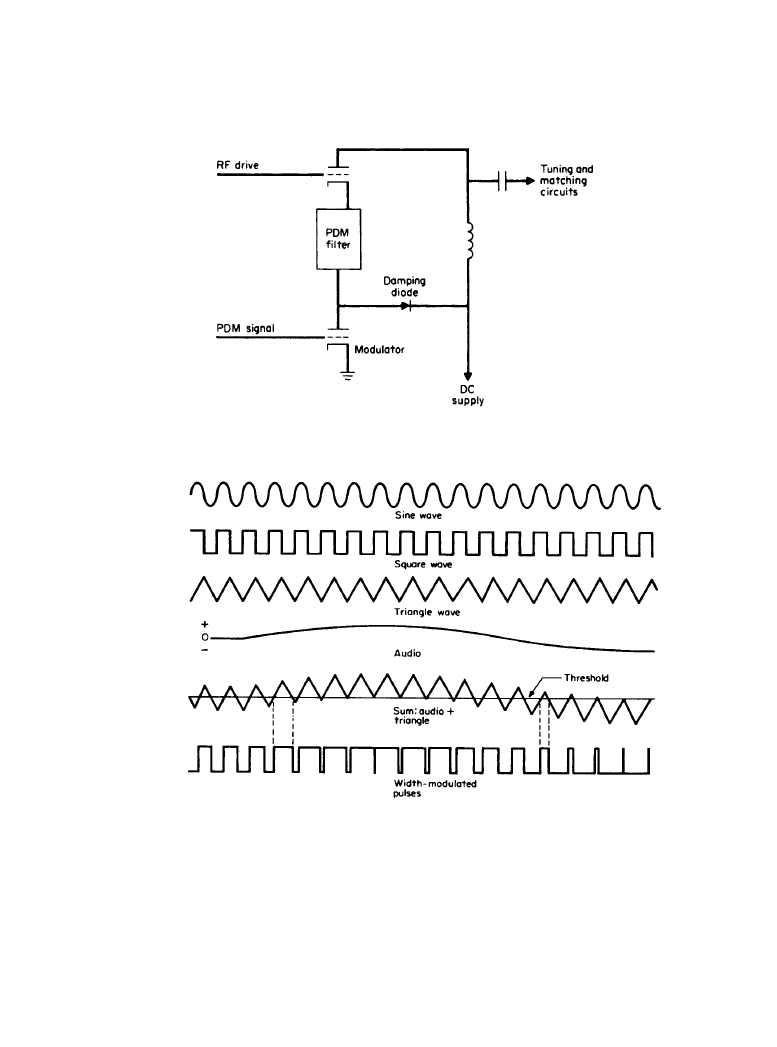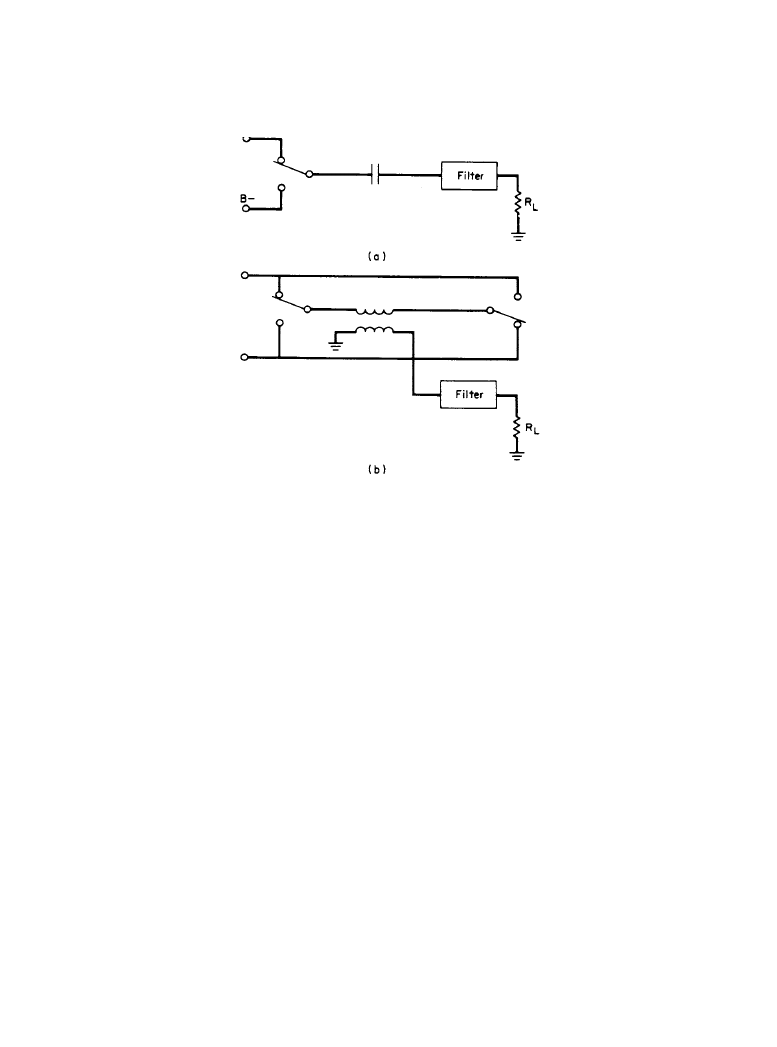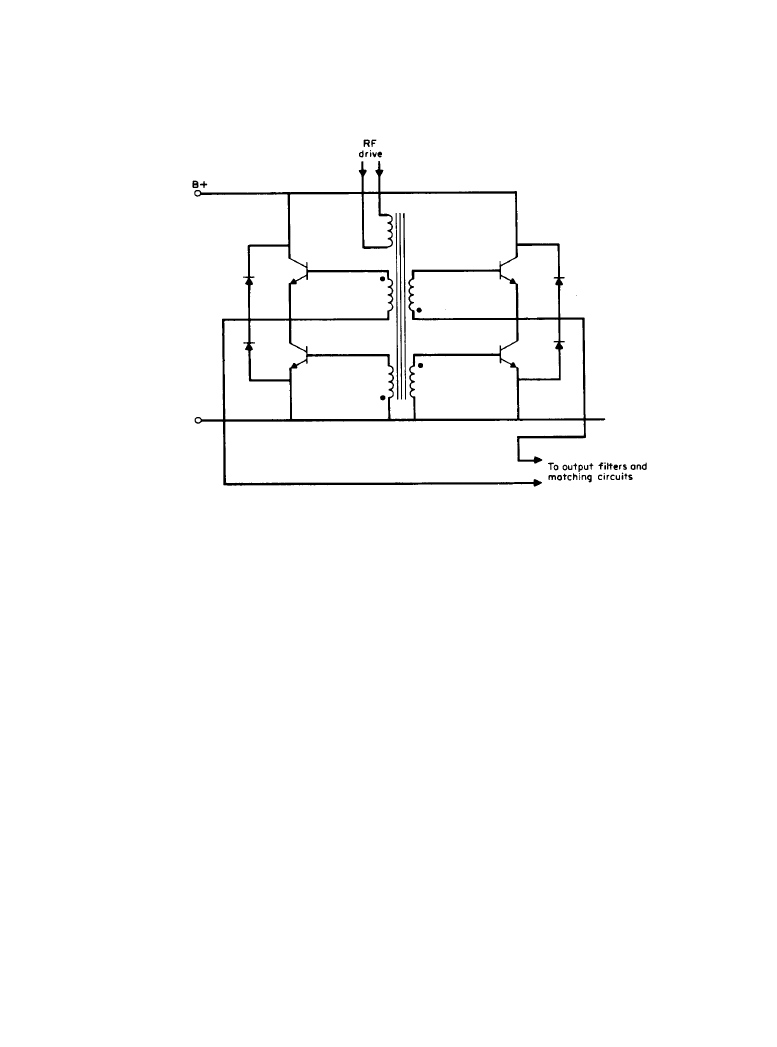ВУЗ: Казахская Национальная Академия Искусств им. Т. Жургенова
Категория: Книга
Дисциплина: Не указана
Добавлен: 03.02.2019
Просмотров: 21677
Скачиваний: 19

11-52 Broadcast Transmission Systems
tively rides on the incoming audio (as shown in Figure 11.3.5). This composite signal is then
applied to a threshold amplifier, which functions as a switch that is turned on whenever the value
of the input signal exceeds a certain limit. The result is a string of pulses in which the width of
pulse is proportional to the period of time the triangular waveform exceeds the threshold. The
Figure 11.3.4
Basic configuration of the PDM system.
Figure 11.3.5
Principle waveforms of the PDM system.
Downloaded from Digital Engineering Library @ McGraw-Hill (www.digitalengineeringlibrary.com)
Copyright © 2004 The McGraw-Hill Companies. All rights reserved.
Any use is subject to the Terms of Use as given at the website.
Radio Broadcasting

Radio Broadcasting 11-53
pulse output is applied to an amplifier to obtain the necessary power to drive subsequent stages.
A filter eliminates whatever transients exist after the switching process is complete.
The PDM scheme is—in effect—a digital modulation system with the audio information
being sampled at a 75-kHz rate. The width of the pulses contain all the audio information. The
pulse-width-modulated signal is applied to a switch or modulator tube. The tube is simply turned
on, to a fully saturated state, or off in accordance with the instantaneous value of the pulse. When
the pulse goes positive, the modulator tube is turned on and the voltage across the tube drops to a
minimum. When the pulse returns to its minimum value, the modulator tube turns off.
This PDM signal becomes the power supply to the final RF amplifier tube. When the modula-
tor is switched on, the final amplifier will have current flow and RF will be generated. When the
switch or modulator tube goes off, the final amplifier current will cease. This system, in effect,
causes the final amplifier to operate in a highly efficient class D switching mode. A dc offset
voltage to the summing amplifier of Figure 11.3.6 is used to set the carrier (no modulation) level
of the transmitter.
A high degree of third-harmonic energy will exist at the output of the final amplifier because
of the switching-mode operation. This energy is eliminated by a third-harmonic trap. The result
is a stable amplifier system that normally operates in excess of 90 percent efficiency. The power
consumed by the modulator and its driver is usually a fraction of a full class B amplifier stage.
The damping diode shown in Figure 11.3.4 is used to prevent potentially damaging transient
overvoltages during the switching process. When the switching tube turns off the supply current
during a period when the final amplifier is conducting, the high current through the inductors
contained in the PDM filters could cause a large transient voltage to be generated. The energy in
the PDM filter is returned to the power supply by the damping diode. If no alternative route were
established, the energy would return by arcing through the modulator tube itself.
The pulse-width-modulation system makes it possible to completely eliminate audio fre-
quency transformers in the transmitter. The result is wide frequency response and low distortion.
It should be noted that variations on this amplifier and modulation scheme have been used by
other manufacturers for both standard broadcast and short-wave service.
Solid-State Transmitters
Solid-state transmitters make use of various schemes employing pulse modulation techniques.
One system is shown in simplified form in Figure 11.3.7a. This method of generating a modu-
lated RF signal employs a solid-state switch to swing back and forth between two voltage levels
Figure 11.3.6
Simplified block diagram of the PDM system
Downloaded from Digital Engineering Library @ McGraw-Hill (www.digitalengineeringlibrary.com)
Copyright © 2004 The McGraw-Hill Companies. All rights reserved.
Any use is subject to the Terms of Use as given at the website.
Radio Broadcasting

11-54 Broadcast Transmission Systems
at the carrier frequency. The result is a square-wave signal that is filtered to eliminate all compo-
nents except the fundamental frequency itself. A push-pull version of the circuit is shown in Fig-
ure 11.3.7b.
Figure 11.3.8 illustrates a class D switching system utilizing bipolar transistors that permits
the generation of a modulated carrier. Modern solid-state transmitters use field-effect-transistor
(FET) power devices as RF amplifiers. Basically, the dc supply to the RF amplifier stages is
switched on and off by an electronic switch in series with a filter. Operating in the class D mode
results in a composite signal similar to that generated by the vacuum-tube class D amplifier in
the PDM system (at much higher power). The individual solid-state amplifiers are typically com-
bined through a toroidal filter/combiner. The result is a group of low-powered amplifiers operat-
ing in parallel and combined to generate the required energy.
Transmitters well above 50 kW have been constructed using this design philosophy. They
have proved to be reliable and efficient. The parallel design provides users with automatic redun-
dancy and has ushered in the era of “graceful degradation” failures. In almost all solid-state
transmitters, the failure of a single power device will reduce the overall power output or modula-
tion capability of the system but will not take the transmitter off the air. This feature allows repair
of defective modules or components at times convenient to the service engineer. The negative
effects on system performance are usually negligible.
The audio performance of current technology solid-state transmitters is usually better than
vacuum-tube designs of comparable power levels. Frequency response is typically within ±1 dB
from 50 Hz to 10 kHz. Distortion is usually less than 1 percent at 95 percent modulation.
Figure 11.3.7
Solid-state switching RF amplifier: (
a) basic system, (b) push-pull configuration.
Downloaded from Digital Engineering Library @ McGraw-Hill (www.digitalengineeringlibrary.com)
Copyright © 2004 The McGraw-Hill Companies. All rights reserved.
Any use is subject to the Terms of Use as given at the website.
Radio Broadcasting

Radio Broadcasting 11-55
11.3.3 FM Broadcasting
Frequency modulation utilizes the audio modulating signal to vary the frequency of the RF car-
rier. The greater the amplitude of the modulating frequency, the greater the frequency deviation
from the center carrier frequency. The rate of the frequency variation is a direct function of the
frequency of the audio modulating signal. In FM modulation, multiple pairs of sidebands are
produced. The actual number of sidebands that make up the modulated wave is determined by
the modulation index (MI) of the system. The modulation index is a function of the frequency
deviation of the system and the applied modulating signal.
As the MI increases there are more sidebands produced. As the modulating frequency
increases for a given maximum deviation, there will be a smaller number of sidebands spaced at
wider intervals. Unlike amplitude modulation, which has a percentage of modulation directly
proportional to the carrier power, the percentage of modulation in FM is generally referenced to
the maximum allowable occupied bandwidth set by regulation. For example, FM broadcast sta-
tions are required to restrict frequency deviation to ±75 kHz from the main carrier. This is
referred to as 100 percent modulation for FM broadcast stations.
To determine the frequency spectrum of a transmitted FM waveform, it is necessary to com-
pute a Fourier series or Fourier expansion to show the actual signal components involved. This
work is difficult for a waveform of this type, as the integrals that must be performed in the Fou-
rier expansion or Fourier series are difficult to solve. The actual result is that the integral pro-
duces a particular class of solution that is identified as the Bessel function.
Figure 11.3.8
Bipolar transistor RF stage operating in a class D switching mode for AM service.
Downloaded from Digital Engineering Library @ McGraw-Hill (www.digitalengineeringlibrary.com)
Copyright © 2004 The McGraw-Hill Companies. All rights reserved.
Any use is subject to the Terms of Use as given at the website.
Radio Broadcasting

11-56 Broadcast Transmission Systems
Supporting mathematics will show that an FM signal using the modulation indices that occur
in a broadcast system will have a multitude of sidebands. To achieve zero distortion, all side-
bands would have to be transmitted, received, and demodulated. However, in reality, the ±75-kHz
maximum deviation for FM broadcasting allows the transmission and reception of audio with
negligible distortion.
The power emitted by an FM transmitter is virtually constant, regardless of the modulating
signal. Additional noise or distortion of the amplitude of the waveform has virtually no effect on
the quality of the received audio. Thus, FM transmitters may utilize Class C type amplifiers,
which cause amplitude distortion but are inherently more efficient than Class A or Class B
amplifiers. In addition, atmospheric and man-made noise has little affect, since the receiver clips
all amplitude variations off the signal prior to demodulation.
11.3.3a
Frequency Modulation
The monophonic system of FM broadcasting was developed to allow sound transmission of
voice and music for reception by the general public for audio frequencies from 50 to 15,000 Hz,
all to be contained within a ±75-kHz RF bandwidth. This technique provided higher fidelity
reception than was available with standard broadcast AM, along with less received noise and
interference. FM broadcasting in the U.S. is allocated the 88 to 108 MHz frequency band.
Pre-emphasis is employed in an FM broadcast transmitter to improve the received signal-to-
noise ratio. The pre-emphasis upper-frequency limit is based on a time constant of 75
µs, as
required by the FCC. Audio frequencies from 50 to 2120 Hz are transmitted with normal FM;
whereas audio frequencies from 2120 Hz to 15 kHz are emphasized with a larger modulation
index. There is significant signal-to-noise improvement at the receiver, which is equipped with a
matching de-emphasis circuit.
11.3.3b
FM Broadcast Modulation Techniques
FM stereo was developed in 1961 to provide transmission capability for a left- and right-stereo
audio signal. Stereophonic transmission is accomplished by adding the left- and right-channel
stereo information together in the baseband signal. In addition, a left-minus-right channel is
added and frequency multiplexed on a subcarrier of 38 kHz using double sideband suppressed
carrier (DSSC) modulation. An unmodulated 19-kHz subcarrier is derived from the 38-kHz sub-
carrier to provide a synchronous demodulation reference for the stereophonic receiver. In the
receiver, a synchronous detector at 38 kHz recovers the left-minus-right channel information,
which is then combined with the left-plus-right channel information in sum and difference com-
biners to produce the original left-channel and right-channel signals. The system works well and,
because the baseband mono signal is a combination of both left and right audio, provides full
compatibility with monophonic FM receivers.
Modulation Circuits
Early FM transmitters used reactance modulators that operated at a low frequency. The output of
the modulator was then multiplied to reach the desired output frequency. This approach was
acceptable for monaural FM transmission but not for modern stereo systems or other applica-
tions that utilize subcarriers on the FM broadcast signal. Modern FM systems utilize direct mod-
ulation. That is, the frequency modulation occurs in a modulated oscillator that operates on a
Downloaded from Digital Engineering Library @ McGraw-Hill (www.digitalengineeringlibrary.com)
Copyright © 2004 The McGraw-Hill Companies. All rights reserved.
Any use is subject to the Terms of Use as given at the website.
Radio Broadcasting